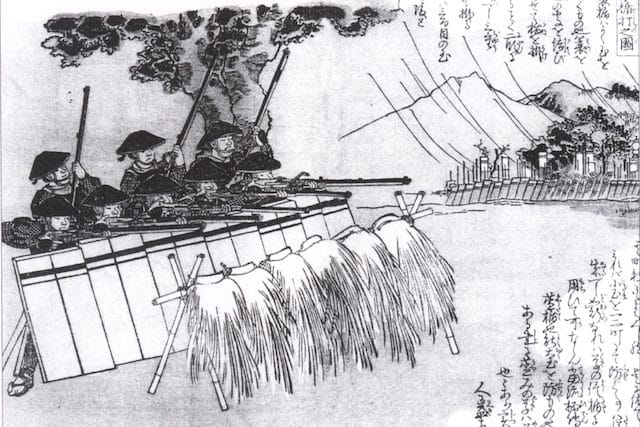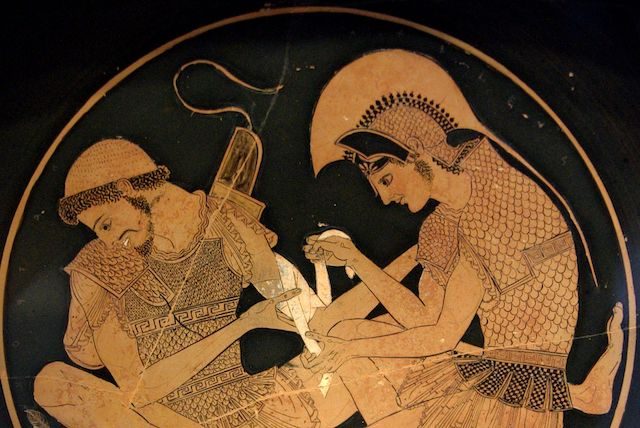Today, we like to think of ourselves as at the highest point ever in human technological advancement, and certainly on some levels we seem to have done better than in the past — such as transportation methods like airplanes. However, many technologies that today we imagine those in the past simply had to live without are not as modern as we thought. In fact, many technologies used in the past were quite effective, they just seem primitive to us today, because they were designed to fulfill their function without displaying things on a screen, or using electricity. Modern man is convinced that something isn’t technology advanced sufficiently if it doesn’t have features of that kind.
10. The “Baghdad Battery” Found In The Ruins Of Ancient Iraq
The “Baghdad Battery” was found in the ruins of what was once Ancient Iraq, and is hotly disputed in the world of archeology. The discovery was a ceramic vessel with a copper tube and an iron rod. Despite the fact that independent experts like the Mythbusters have proven that with an electrolytic solution, it would become a battery, some archeologists still stubbornly argue that it must have just held scrolls or something, probably because accepting that there is a battery lying around would destroy a lot of conceptions they have about the history of the area.
Now, if it were a battery, the bigger question is what it was used for. It has been suggested it was used for electroplating gold to other metals, but all experts who have looked at the metalwork believe that simple fire gilding was actually used. Due to the complete lack of any kind of evidence of what it could have been used for, it has been speculated that it was meant for some kind of electrotherapy or other medical application. Unfortunately, it’s hard to know if we will ever get any answers, as we have discovered nothing written down on the matter. While some archeologists are skeptical of discoveries like this, due to lack of physical evidence of widespread use of electricity, the fact of the matter is that the basics of making electricity work are metals, and these are one of the first things looted when society breaks down — there simply may not be much intact physical evidence that is extant.
9. Several Ancient Cultures Had Forms Of Air Conditioning

Today we like to think of ourselves at the pinnacle of modern technology, and one of our greatest technological feats is air conditioning, an invention so modern, and arguably bad for the environment, that some probably wonder if it should even be a thing. However, many of us could no longer live without it. While some of us shake our heads silently and wonder about the time when there was no air conditioning, pondering how the people of old could have survived without it, the truth is that many of them had their own methods that actually worked quite well.
The Ancient Romans forced water from the famous aqueduct system through pipes in their homes, and kept the house cool and insulated all year round. Many structures in the hottest parts of the Middle East have long used spiral shapes that create a cooling wind effect, and many cultures have taken advantage of the coolness of going underground, and created houses, or even whole cities that are partially underground, in order to efficiently cool themselves. There are also surprising strategies that many people do not think of. It may seem strange to see people in the desert wearing full robes, and it may appear they are just used to the heat, but there is good reason for it. These clothes have been scientifically shown to create a cooling from effect the way they drape and flow around the body. Taking off your shirt actually just exposes you directly to the heat, and makes you sweat out the moisture in your body faster.
8. Hot Air Balloons Go Back To When They Were Used For Messaging In Ancient China

Today, hot air balloons still have their enthusiasts, and are a novel and horrifying way to float across the sky, largely at the mercy of forces beyond your control. Now, this isn’t to say that they are simply floating death machines — if you have proper training, experience and understand weather conditions, it can be safe and fun. The truth is that hot air balloon accidents are very rare; however, long before they were experimented with as a means of attempting to traverse the entire globe, they were used for sending messages.
Back in the early days of Ancient China, they used small hot air balloons meant not for carrying people or cargo, but for sending messages. By sending mini hot air balloons into the sky, the flaming “sky lanterns” would signify to others that help was needed or be understand as a military command of some kind or another. Like with the invention of gunpowder, it had started off mostly as a novelty, then it saw more utilitarian use, and then it became another terrifying part of the arsenal of war. If technology of most kinds were to ever be unavailable, it is hard to argue with the effectiveness of this method. It would be easy to float many lanterns to a great height, and especially at night, they would be seen for a very long distance.
7. People Exploited The Denseness Of Air To Create Primitive “Refrigerators”
Refrigerators, and the accompanying freezer, are considered by most to be one of the most modern inventions available, but people have long desired to keep their food from spoiling and have gotten very creative over the years. While today we use lots of electricity, which is usually backed by things like coal, and still require chemicals like freon that are very bad for the environment, back in the day, methods were a lot simpler. The Romans would create underground freezers by shipping in snow from the mountains, packing it in the ground, and then packing layers of dirt on top to insulate the snow around it. Then in the underground chamber they created, they could store food.
For those who don’t have access to methods quite this complicated, most people simply made use of the fact that cold air is much denser than hot air. Or as the saying goes, “hot air rises and cold air falls.” This means that the lower underground you are, and the better you know how to insulate, the colder you can consistently keep an area. Most people were unable to maintain consistent freezer temperatures, depending on the region of the world, but most could at least manage something close to a consistent refrigerator temperature.
6. Guns Have Been Used In Combat Much Farther Back Than Most People Realize

Guns are easily considered the deadliest weapons today — mass killings are performed by guns nearly every time, and it is the constant subject of public debate as to whether we should ban or restrict guns, and the constant drive of military forces around the world to make their guns stronger. In most people’s eyes, guns not only saw most of their development within the last couple hundred years or so, but they really only saw heavy use at all from that time period forward.
However, the fact is that guns were being used, and even used heavily in combat to great effect, long before people were struggling about with muskets and lining up on the battlefield. There is European Medieval artwork depicting soldiers wielding guns, although the Europeans were not known to use them often. On the other hand, the Japanese during their own medieval period, from the mid 1500s through 1600s, built a lot of guns, used them heavily in combat, and figured them into their military strategies. Now, guns are certainly much more powerful than they were once, but they have been the weapon of favor in at least one culture, fallen out of favor, and then come back into favor again. Ironically, in a way, the Japanese have once again pivoted back to not being in favor of the gun, as they have no real standing military and guns are heavily banned in the country.
5. Devices Like The Antikythera Mechanism Allowed For Incredible Mathematical Analysis

Today, we like to think of our understanding of mathematics as far beyond what ancient man could do, but we are not nearly as far ahead as we would like to think. A device called the antikythera mechanism — due to it being found in wreckage off the coast of a Greek island called Antikythera — was discovered in the early 1900s and changed the way that many people look at the ancient world. The device is made from 37 different mesh and metal gears, and its workings are insanely complex.
It was designed as an analog computer that could predict the movements of the stars, the irregular phases of the moon, and other astronomical calculations decades in advance with incredible accuracy. Historians who have examined it believe the device was probably designed by a team of ancient Greek scientists, back somewhere in the general range of about 100-200 BC. Now, some people may still consider this pretty primitive compared to what we have today, but apart from the fact that it does not use electricity, and doesn’t have a screen to show you results, it could do almost everything we could do in terms of future star movement predictions, which requires a lot of complicated math and analysis. Screens are a convenience, but they are not the only way to output data, and are best for entertainment more than anything else.
4. The Telegraph Was Basically The Texting And Internet Of The Olden Days

The telegraph recently went fully defunct a few years ago, and many people were saddened by the end of an old timey era of communication. However, while the telegraph was eventually chosen in favor of other technologies, it was hardly primitive, and allowed for a widespread level of communication that most people tend to think we only have today. The telegraph was cheap, easy to use, and allowed people to get quick messages across without the commitment of a phone call. It was basically a combination of instant messenger and text of today, and people used it that way like crazy.
The telegraph had its own version of text speak, which was very similar to ours today — and very important for them, as telegrams were charged by the character. And, evidence shows that people shared their day’s equivalent of memes over the telegram on a regular basis. While the telegraph did slowly lose popularity to other technologies that came out in the ensuing years, it was capable of connecting people in a way that most only attribute to the internet’s abilities today, and it did it without the incredible layers of technology that most communication requires today.
3. Ancient Cultures Had Surprisingly Sophisticated GPS Equipment

Today, we take for granted our ability to use GPS technology. We say something to our smartphone, and the next thing we know we have found our way to the nearest Denny’s or, if we are really unlucky, right into a pond, or a closed access road. The GPS requires no input at all from us beyond telling it where we want to go, and following directions. Now, ancient cultures certainly didn’t have anything quite like this, but they did have surprisingly sophisticated devices for navigating around, and it made them much better navigators than most of us are today.
Back in the day, without global positioning satellites to rely on, they had to understand the positions of the stars. However, just knowing all of the stars and their positioning and understanding ocean currents and everything else wasn’t quite enough. Sometimes you needed tools. The sextant was a crucial device that was invented by John Hadley, although there is some reason to believe he may have been influenced by past writings of Isaac Newton, who was deceased at the time of the invention. Regardless, this device helped measure the angle between the horizon and the stars, which meant someone with proper astronomical knowledge could use this to navigate extremely effectively.
Another useful invention was the Bygrave Position-Line Slide Rule, a device cooked up much more recently after World War I by a Captain L. C. Bygrave, and was useful for quickly putting together proper navigational calculations on the fly. Well before computers, we were able to navigate just fine, with just a little bit of our own brain power added into our analog technology to help us along the way.
2. The Use Of Condoms And Pregnancy Tests Goes Back A Very Long Way
Today we tend to think that now we finally have birth control, proper pregnancy tests, and are able to have a certain control and knowledge of our destiny that people of the past simply did not. Women can pee on a stick and in a short time, know if they are actually pregnant or not like they hoped — or feared. Birth control is also much more effective, as there are pills women can can take on a regular basis to avoid pregnancy, and condoms are cheap and plentiful all over the place.
However, long in the past, people actually had far more access to these technologies and these conveniences than people think. Pregnancy testing goes back a long time, as we’ve covered before. The interesting thing is that essentially every single culture was actually looking in the right direction, and most of their methods were either extremely accurate, or at least really close. All of the methods you will see offered by ancient cultures involved analyzing the urine in some form or another to see if it was different from the urine of a woman who was not pregnant.
In terms of condoms, full condoms have been found in the middle ages in Europe, made from animal bits, and in China and Japan, glans condoms that only covered the head of the penis were actually quite popular among the elite who could afford them. In many ways, history repeats itself, as inventions like this have, in some respects, gone in and out of popularity over time.
1. Kevlar Is A Rediscovery Of A Very Old Means Of Combat Protection

We like to think that people tried leather and metal body armor, and after a time, realized that it just wasn’t that effective. Eventually, people came to their senses, and now we have the recently invented Kevlar, which provides far greater protection than ever in the past. However, the truth is that Kevlar is not some kind of special technological advancement. It is basically just lots of fibers sewed in layers very tightly together, providing great resistance to any bullets or other shrapnel that may try to get through. This technology is actually something that can be replicated to a great degree without fancy machinery, and appears in countless pieces of literature when it comes to battles in the ancient world.
The Ancient Greeks were said to have made use of it, among others, and found it to often be a better form of protection against arrows than many other methods. Historians at the University of Wisconsin Green Bay have been studying the practical effects, and found that it should have theoretically worked as well as the historical records suggest. The historians have been attempting to replicate a specific type of cloth armor worn by Alexander the Great and his men, called the linothorax — made by compressing together many layers of fabric much like Kevlar — which give them an edge that allowed him to almost conquer the world long ago. Historians believe that we see little evidence of it in the historical record, and may never be able to truly and properly replicate the linothorax, because of its unique design. Since it is made out of cloth fibers, it degrades very easily over time compared to metal or treated leather, and so there may simply not be any artifacts to find.
2 Comments
The Rebels have had an unpleasant season, with the terminating of their head mentor Hugh Freeze prior in the season, yet beating Mississippi State would give them boasting rights, as well as give them a .500 record.
Ole Miss took a self– forced bowl boycott for this season after the NCAA accused the program of absence of institutional control.
Mississippi State skiped from a nearby misfortune to Alabama to dispatch Arkansas 31– 24.
Scratch Fitzgerald has been one of the SEC’s best quarterbacks, tossing for 1,770 yards and 15 touchdowns. He likewise drives the group in surging with 968 yards and 14 scores on the ground.
http://sportsdawn.com/watch-ole-miss-vs-mississippi-state-live-stream/